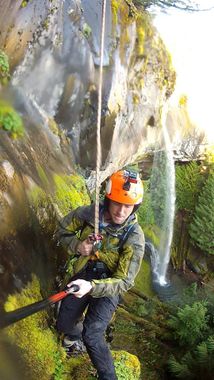Spiderman Creek
Jump to navigation
Jump to search
| Rating: | |||||||||||||||||||||||||||||||
|---|---|---|---|---|---|---|---|---|---|---|---|---|---|---|---|---|---|---|---|---|---|---|---|---|---|---|---|---|---|---|---|
| | Raps:2, max ↨130ft
Red Tape:No permit required Shuttle: Vehicle:Passenger | ||||||||||||||||||||||||||||||
| Location: | |||||||||||||||||||||||||||||||
| Condition Reports: | 23 Mar 2014
"Explored the canyon and rappelled the first 2 waterfalls. The exit is a bit challenging as I climbed up the way the map shows, but I suspect an easier |
||||||||||||||||||||||||||||||
| Best season: | Spring or Fall
|
||||||||||||||||||||||||||||||
| Regions: | |||||||||||||||||||||||||||||||
Introduction[edit]
2 large undercut waterfalls over 100' tall. Trees grow behind the amphitheater of the first one the space is so large.
Approach[edit]
From NF-202 find the small turnoff on the right which is an old over grown road. Park at the beginning of the road and use the road to get close to the waterfall.
Descent[edit]
No trees are near the edges of the waterfalls. Bolts would be great to have installed here (but none exist currently). Use trees or whatever you can find to rappel down.
Exit[edit]
Hike DCL up steep loose rock and traverse the base of the cliff as shown on the map. There is a steep climb up a gully before you reach the top of the hill. Possible exit down river with a shuttle.
Red tape[edit]
Beta sites[edit]
Trip reports and media[edit]
Background[edit]
This canyon was first descended by Adam DiPietro and Steve Schachner in Spring 2014
